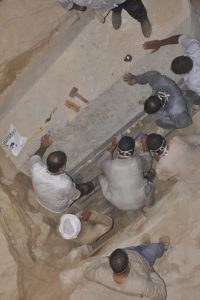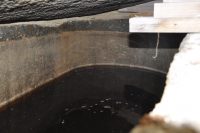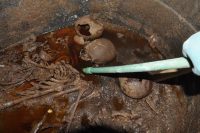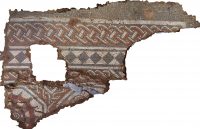 The exploration of the wreck of the 16th century Swedish warship Mars 250 feet under the surface of the cold, dark Baltic Sea has been ongoing since its discovery in 2011, and despite the zero visibility and the life-threatening challenges involved in diving the wreck, new finds continue to be made.
The exploration of the wreck of the 16th century Swedish warship Mars 250 feet under the surface of the cold, dark Baltic Sea has been ongoing since its discovery in 2011, and despite the zero visibility and the life-threatening challenges involved in diving the wreck, new finds continue to be made.
“This year, we have come closer to the people aboard. We found more skeletal parts, including a femur with trauma around the knee which we believe to stem from a sharp-edged weapon,” says maritime archaeologist Rolf Fabricius Warming, who is one of the researchers involved in the investigation.
“We also found large guns and a hand grenade. We can see from the wreckage that it was a very intense and tough battle. Between 800 and 1,000 men were on board. That is comparable to the population of an entire medium-sized town at the time. Most of them died in the explosion or when the ship sank into the watery depths,” he says.
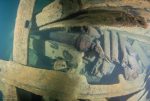 The ship was the largest in the fleet of King Eric XIV (r. 1560-1568), capable of carrying a crew of 800. The reason for the estimate of how many went down with the ship is that it sank mid-boarding. The Swedish navy engaged in battle against Denmark, Lübeck and the Polish–Lithuanian Union off the coast of Öland on May 30th, 1564. On the second day of ferocious fighting, the Mars was boarded by the Danish and Lübeckian forces who didn’t know that the ship was already on fire from a cannon shot. The gunpowder stores exploded with enormous force, blowing the front of the ship clean off — that part of the wreck was found 130 feet away from the main body of the ship — and killing whatever crew had survived up until that point died along with the enemy they had been fighting. Historians estimate that at least 300 of the dead of the Mars were Danish-Lübeckian boarders.
The ship was the largest in the fleet of King Eric XIV (r. 1560-1568), capable of carrying a crew of 800. The reason for the estimate of how many went down with the ship is that it sank mid-boarding. The Swedish navy engaged in battle against Denmark, Lübeck and the Polish–Lithuanian Union off the coast of Öland on May 30th, 1564. On the second day of ferocious fighting, the Mars was boarded by the Danish and Lübeckian forces who didn’t know that the ship was already on fire from a cannon shot. The gunpowder stores exploded with enormous force, blowing the front of the ship clean off — that part of the wreck was found 130 feet away from the main body of the ship — and killing whatever crew had survived up until that point died along with the enemy they had been fighting. Historians estimate that at least 300 of the dead of the Mars were Danish-Lübeckian boarders.
The diving team has also discovered a historic first this season.
This time, one of the most spectacular finds was a large grapnel (grappling hook) an anchor-like hook, which hung from the bowsprits of warships and was used to cling onto another ships in order to board it.
Grapnels are illustrated in historical sources from the 16th century, but no actual surviving examples are known apart from this particular one, says Warming.
“It’s totally unique. Together with other exciting finds, it can shed new light on Medieval and Early Modern naval warfare,” he says, and adds that the divers also found remains of possible arms and armour, including helmets and swords.
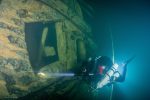 Alas, there are no pictures of the grappling hook which is a bummer, but we must forgive because visibility down there is so terrible that it’s a miracle we get any photos at all, never mind the exceptional ones we’ve gotten so far. The divers have to use high-intensity bright lights to see a foot in front of their masks and they film everything they see for the archaeologists to examine. They do this carrying big tanks with a special gas mixture to keep them from getting the bends/dying and under a crazy time crunch because for their own safety, they can only dive 40 minutes at a time.
Alas, there are no pictures of the grappling hook which is a bummer, but we must forgive because visibility down there is so terrible that it’s a miracle we get any photos at all, never mind the exceptional ones we’ve gotten so far. The divers have to use high-intensity bright lights to see a foot in front of their masks and they film everything they see for the archaeologists to examine. They do this carrying big tanks with a special gas mixture to keep them from getting the bends/dying and under a crazy time crunch because for their own safety, they can only dive 40 minutes at a time.
That precious footage they’ve shot is being used to create a detailed ultra high-resolution 3D model of the shipwreck. It’s not complete yet, but here’s an all-too brief demo of the 3D photogrammetry model of the Mars and it’s awesome.

